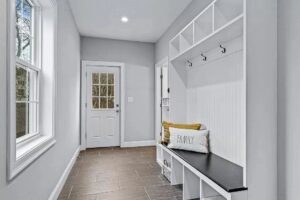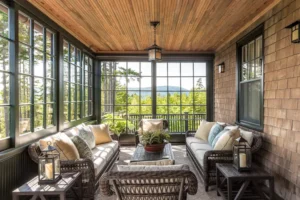A mudroom addition serves as the first point of contact for anyone entering your home. As such, it needs to be both functional and aesthetically pleasing. The primary purpose of a mudroom addition or entrance addition is to provide a designated area for removing and storing outerwear, footwear, and other items before entering the main living areas. This helps to keep your home clean and organized, especially in regions with varied weather conditions where mud, snow, and rain are common.
The foundation of an effective mudroom lies in its storage solutions. To begin with, consider the layout and size of the space you have available. Whether you are working with a small corner near an entrance or a larger, dedicated room, thoughtful planning is crucial. Start by identifying the key items that need to be stored: shoes, jackets, bags, and outdoor gear. With these in mind, you can design a space that maximizes storage and efficiency.
One of the most important elements of a mudroom is shoe storage. Shoes tend to accumulate quickly, creating clutter and mess if not properly managed. There are several effective shoe storage options to consider. Built-in cubbies or shelves are a popular choice, providing a designated spot for each pair of shoes. These can be open or closed, depending on your preference for visibility and tidiness. Adjustable shelves offer flexibility to accommodate various shoe sizes, from kids’ sneakers to adults’ boots.
Another effective solution is the use of benches with built-in storage. These multifunctional pieces not only provide a comfortable place to sit while putting on or taking off shoes but also offer hidden storage underneath. Drawers or lift-up seats can keep shoes out of sight while still being easily accessible. For families with young children, low shelves or baskets can help encourage kids to store their shoes independently, fostering good organizational habits from an early age.
Jacket and outerwear storage is equally important in a mudroom. A combination of hooks, cubbies, and closets can effectively manage coats, jackets, and accessories. Wall-mounted hooks or pegs are ideal for hanging frequently used items, such as jackets, hats, and bags. Placing these hooks at varying heights ensures that even the youngest family members can easily hang up their own belongings.
For a more organized look, consider incorporating lockers or cubbies into your mudroom design. These provide individual storage spaces for each family member, helping to keep items separated and easy to locate. Lockers can be customized with doors to conceal clutter or left open for a more casual, accessible feel. Including nameplates or labels on each locker can further personalize the space and promote organization.
Closets in the mudroom offer additional storage for seasonal items and less frequently used outerwear. A combination of hanging rods, shelves, and bins within the closet can accommodate everything from winter coats to sports equipment. Sliding or bi-fold doors help to save space in smaller mudrooms while still providing easy access to stored items.
To maximize storage efficiency, consider integrating custom cabinetry into your mudroom design. Custom cabinets can be tailored to fit the exact dimensions of your space and meet your specific storage needs. Upper cabinets provide storage for items that are used less frequently, such as hats, gloves, and scarves, while lower cabinets and drawers keep shoes and boots organized and out of sight.
In addition to storage for shoes and jackets, a well-designed mudroom can accommodate a variety of other items. Shelves and bins for mail, keys, and other small items help to prevent clutter from migrating into the main living areas. A designated space for backpacks, sports gear, and school supplies can keep everything organized and easily accessible for busy mornings. Incorporating a message board or calendar can also help keep track of family schedules and important events.
The materials and finishes you choose for your mudroom are also important considerations. Durable, easy-to-clean materials are essential, given the mudroom’s role as a transition space between the outdoors and indoors. Tile or vinyl flooring is a practical choice, as these materials can withstand moisture and are easy to clean. Consider installing a mat or rug at the entrance to help trap dirt and prevent it from spreading throughout the home.
Cabinetry and shelving should be made from robust materials that can endure daily use. Painted or laminated finishes are popular for their ease of maintenance and ability to complement various design styles. For a touch of warmth and style, consider incorporating natural wood accents, such as a wooden bench or trim.
Lighting is another crucial aspect of mudroom design. Adequate lighting ensures that the space is both functional and inviting. Overhead lighting provides general illumination, while task lighting, such as wall sconces or under-cabinet lights, can enhance visibility in specific areas. Natural light from windows or skylights can also make the space feel brighter and more welcoming.



